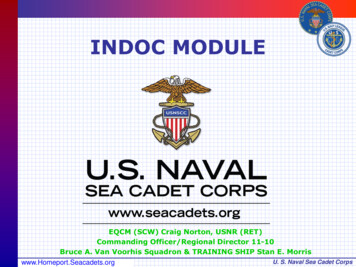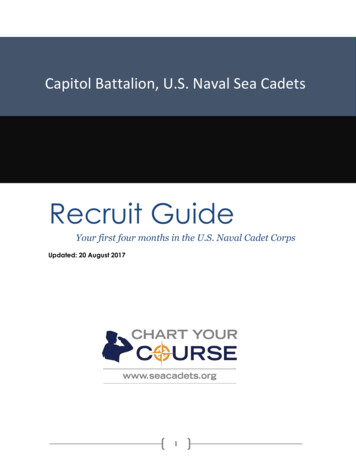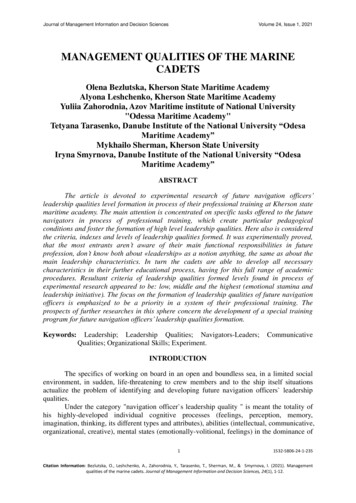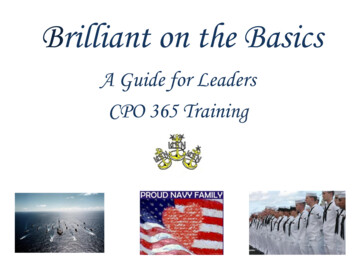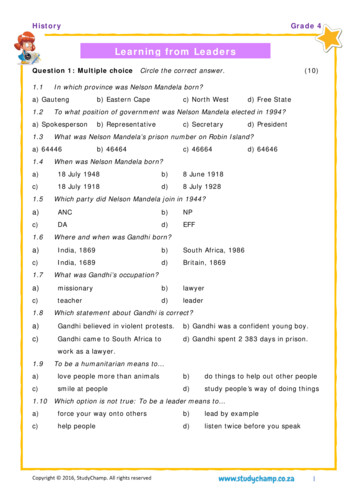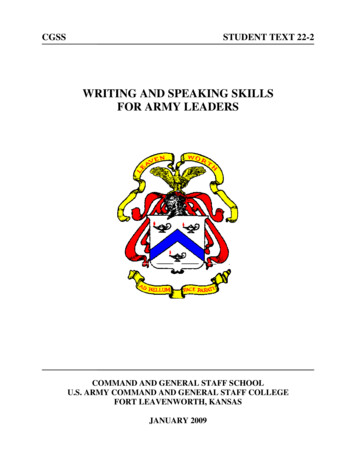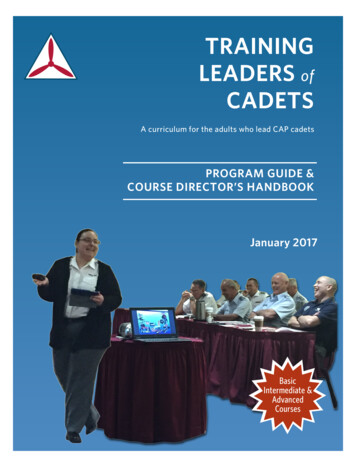
Transcription
TRAININGLEADERS ofCADETSA curriculum for the adults who lead CAP cadetsPROGRAM GUIDE &COURSE DIRECTOR’S HANDBOOKJanuary 2017BasicIntermediate &AdvancedCourses1
TRAINING LEADERS OF CADETSPROGRAM GUIDE & COURSE DIRECTOR’S HANDBOOKJanuary 2017Training Leaders of Cadets is the premiere venue for Cadet ProgramOfficers to learn how to become better mentors of cadets and moreeffective managers of cadet squadrons. The 3-course program is acomponent of the Cadet Programs Officer Specialty Track in the SeniorMember Professional Development Program.Preface to the 2017 Edition11. Program Goals & Content Outlines2TLC Basic Course3TLC Intermediate Course7TLC Advanced Course (currently incomplete)112. Implementation Guidelines for TLC Directors12Operating Standards12National Headquarters Support12Instructor Preparation13Equipment List13Suggested Planning Timeline14Suggested Announcement15Frequently Asked Questions16Appendix: Transition Plan for Compliance Matters17On the Cover. We honor Lt Col Margarita Mesones of Florida for directing TLC during numerous National Conferences, lendingher expertise to many wings needing the services of a master instructor, and contributing to this edition of the course.2
Preface to the 2017 EditionEvery generation of cadets says that the #1 factor contributing to the success of their cadet experienceis the quality of adult leaders. Therefore, the importance of the Training Leaders of Cadets program,which is the premiere forum for adult volunteers to learn how to mentor cadets and implement asuccessful Cadet Program, cannot be overstated.For ten years, until 2016, the program was delivered as a single, 1.5-day course. Students andinstructors reported high satisfaction with that curriculum, yet too many adult volunteers could notparticipate due to the multi-day format. Therefore, the main purpose of the redesign that producedthis 2016 edition has been to find ways to deliver the most essential information via a 1-day format,and to encourage intermediate and advanced students to keep coming back for more.Objectives for this Revision of TLC1. Convert the program to a 1-day format, thereby making it easier for more students to participate,and easier for wings to host2. Provide quick-start opportunities for seniors “drafted” into a Cadet Program role, available prior totheir attending the course3. Expand the curriculum to address the needs of advanced students and wing Cadet Programs staff4. Maximize the time available for discussion by converting knowledge-level briefings into online,pre-arrival modules5. Promote currency and continuing education among CP officers by placing an expiration date onthe TLC credential. (A member would be “TLC current” if he or she has completed any TLC course inthe previous 48 months, but this rule will not take effect until CAPR 52-16 is revised.)1
1. Program Goals & Content OutlinesEnduring Goal: Equip adult volunteers with the knowledge and skills necessary for mentoring cadetsand implementing the Cadet Program at the squadron and wing level.1TLCBasic Course2TLCIntermediate Course3TLCAdvanced CourseFormat: 7 hours of discussionbased learning in-residence,with two short web modulesFormat: 8 hours of discussionbased learning in-residence,with three short web modulesFormat: 6 hours of discussionbased learning and briefingsdelivered via NHQ-hostedwebinarsOutcome: Adult leadersprepared to contribute asCadet Programs Officers ona squadron staffOutcome: Cadet ProgramsOfficers prepared to lead asquadron’s Cadet ProgramOutcome: Cadet ProgramsOfficers prepared to administera wing Cadet ProgramTarget Audience:Target Audience:Target Audience: New adult volunteers Graduates of the TLC Basic Graduates of the TLC Adult volunteers serving inpositions below squadrondeputy commander Veteran CP officers seekingrefresher trainingCourseIntermediate Course Adult volunteers preparing Adult volunteers recentlythemselves for service as aappointed as Region or Wingsquadron commander orDCPsdeputy commander forcadets Veteran CP officers seekingrefresher training2
TLC Basic Course OutlineBlock 1Introduction to the Cadet Program1.1 Elements, Traits, & Outcomes45 minKey Question: What does the Cadet Program aim to accomplish and why?Activity: Follow-along worksheet DemographicsProgram missionProgram elementsKey traits of cadet lifeOur #1 challenge1.2 Cadet AdvancementONLINE1.3 Review: Cadet Advancement20 minKey Question: How do cadets advance through their program?Activity: Web module completed before arrival, followed by a promotion status exercises worksheetcompleted as a review Block 2Promotion pre-requisitesTesting systemOnline promotion applicationCadet Super Chart & Personal TrackerLeadership Feedback process (CAPF 50)Cadet Program Leaders2.1 Cadet Programs Officers50 minKey Question: How does the adult staff work together to serve cadets?Activity: Working in pairs, students transferred tasks and responsibilities from a common bank to therespective staff officer; students then build upon that basic knowledge of job functions through adiscussion about best practices for each position. Starter: The army behind the scenesOverview: The Cadet Programs OfficerActivity: Research & reportBest practices additionsConclusion3
2.2 Service Learning80 minKey Question: How do cadet program officers establish, supervise, and guide a cadet staff?Activity: Design a squadron staff and defend its structure by referencing the modular designs found inthe Cadet Staff Handbook. Block 3Starter: Wreaths Across AmericaService learning principlesAnatomy of a cadet staffCadet staff design principlesCadet staff selection practicesActivitySquadron-Level Cadet Program3.1 Cadet Great StartONLINEKey Question: How and why does CAP use Cadet Great Start for cadet orientations? Recruiting models: pipeline v. trickle inOpen House programComprehensive, structured orientationSuccess stories, best practicesNew Cadet Kit & Curry Blues Voucher3.2 Squadron Meetings50 minKey Question: What are the hallmarks of great squadron meetings, and why are meetings soimportant?Activity: Each student critiques a few of the sample meeting schedules provided; then, each studentcreates a schedule for an upcoming meeting in their squadron and shares it with a classmate forconstructive criticism. Starter: A visit to the local squadronKey principlesMinimum monthly requirementsMeeting templateSchedule coordination processCheck ride systemBest practicesActivity4
3.3 Cadet Activities I50 minKey Question: What are some fun opportunities available beyond the squadron meeting, and what arethe key rules and procedures governing them?Activity: Show and tell about successful local activities and through discussion, draft a list of genericactivity planning principles that students could use as a checklist. Local “Saturday” opportunitiesWing-specific programs (local info)Flying: national system, local proceduresAuthorizations & publicity3.4 Quality Cadet Units50 minKey Question: How can you use the QCUA to guide your squadron through a successful year?Activity: Check unit’s QCUA status and identify potential solutions. Starter: Mount EverestOverview: MetricsCompliance metricsPeer supportSelf assessmentsSpecial emphasis:Commander’s DashboardQuality Cadet Unit AwardActivity3.5 Continuing Education15 minKey Question: When TLC is over, what are your next steps for improving your skills and knowledge asa cadet programs officer? Top ten self-help continuing education resourcesProfessionalism5
Suggested Schedule TLC Basic CourseStartLesson0800Z.1 Greetings & Overview08201.109202.1 Cadet Programs Officers10203.2 Squadron Meetings1110Lunch (eat-in)12001.3 Review: Cadet Advancement12203.3 Cadet Activities I13202.2 Service Learning15003.4 Quality Cadet Units16003.5 Continuing Education1615Z.2 Conclusion1630DepartElements, Traits & OutcomesMost activities are 50 minutes in duration, but are shown here as being 1 hour; a 10-minute breakshould be assumed between each major event on the schedule.6
TLC Intermediate Course OutlineBlock 1Cadets as Learners1.1 Generation Z as LearnersONLINEKey Question: What are the characteristics of Generation Z, and what are the different domains oflearning that go into educating a whole person, and how are those domains expressed in lesson plansand assessments in the Cadet Program? Generation Z’s facts and characteristicsImplications for CAPAims of educationCognitive: BloomAffective: KrawtholMoral: KohlbergHow lesson plans workAssessments in the Cadet Program1.2 Special Needs Cadets40 minKey Question: What is CAP’s policy regarding special needs cadets, and what specificaccommodations might local leaders use in serving them?Activity: Scenarios, with students describing inclusive and anti-inclusive responses Policy & visionMaximum inclusion in the least restrictive environmentStarting points for accommodationsSuccess stories7
Block 2Positive Leadership2.1 Transformational Leadership of Cadets60 minKey Question: What does it mean to be a “transformational” leader? How can you usetransformational leadership methods to develop cadets?Activity: Case studies Precepts, via the Full Range Leadership Model4 I’s of transformational leadershipTransformational leadership applied to a cadet projectHazard: the adult ego2.2 Feedback & Mentoring50 minKey Question: What is the cadet program officer’s role in providing feedback, and specifically how areleadership feedback meetings supposed to work?Activity: CAPF 50 development & role playing exercise. Johari windowHabit of self-criticismLeadership expectationsThe CAPF 50Feedback meeting practices2.3 Progressive Discipline60 minKey Question: Can discipline be a learning experience?Activity: Scenarios, with students identifying lessons to be learned and suitable consequences Traits supporting character educationVirtue & its three requirementsBiological development (adolescent brain)Moral development (Kohlberg and ethic of care)CAP as a “safe place to fail”CAP’s continuum of disciplinary interventions2.4 Partnering with Parents60 minKey Question: How can we develop partnerships with parents?Activity: Role-playing exercise, with each student serving once as commander, parent, and debriefer Parents’ expectationsChallenges facing young seniorsBuilding relationshipsService 101Delivering tough news8
Block 3Program Elements in Depth3.1 Tour of the Cadet Curriculum50 minKey Question: What curricular resources are available in each of the program elements, and what aresome of the guidelines leaders should know to implement them effectively?Activity: Poster pad walk-about for each of the four elements.Block 4Safe & Challenging Activities4.1 Cadet Activities II50 minKey Question: What are the premiere wing- and national-level activities available to cadets, and whatadministrative procedures and operating guidelines govern them? Activity plans & their relationship to the squadron’s annual goalsNCSA & scholarship opportunitiesColor guard & cadet competitionES trainingWreaths Across AmericaService projectsSuccess stories4.3 Cadet Safety & WelfareONLINEKey Question: What are the most common safety issues in cadet life, and what are some bestpractices local leaders can use to create a pro-safety culture?Activity: Case study Two deep for better decisionsMost common safety issues for cadetsActivity plans & CAPF 32’sLeadership for a pro-safety cultureAdvanced CPP follow-up Q&A9
Suggested Schedule TLC Intermediate CourseStartLesson0800Z.1 Greetings & Overview08203.1 Tour of the Cadet Curriculum09204.1 Cadet Activities II10202.1 Transformational Leadership1120Lunch (eat-in)12001.2 Special Needs Cadets12502.2 Feedback & Mentoring13502.3 Progressive Discipline15002.4 Partnering With Parents1600Z2. Conclusion1630DepartBreaks are not specifically listed, but each activity should end approximately 10-minutes before thenext one begins to allow for a short stretch break. However, breaks are not suggested after two classesend, Z1 Greetings & Overview and 2.4 Partnering With Parents.10
TLC Advanced Course OutlineThe TLC Advanced Course is delivered only in webinars lead by NHQ. Participation will be limited, and newDCPs will receive priority seating. The TLC Advanced Course is not a requirement for any level in the CadetPrograms Specialty Track.Further program details will be forthcoming in 2017.Block 1Organizational Leadership1.1 Supporting the Commander1.2 Service Recovery1.3 Squadron Support & SupervisionBlock 2Program Leadership2.1 Cadet Advisory Councils2.2 Cadet Activities III2.3 Encampments2.4 NHQ Support Programs2.5 Best Practice Exchange11
2. Implementation Guidelines for TLC DirectorsOperating StandardsEducational Setting. To help expose students to diverse leadership practices and success stories, TLCis conducted at the group level or higher. It is not to be conducted where all participants come from asingle squadron, as group discussion and the sharing of new ideas is an essential part of the course.OPR. The group or wing director of cadet programs is the officer of primary responsibility for the TLCprogram. DCPs are responsible for ensuring TLC is offered annually.Course Leadership. The commander of the hosting unit (a group commander or higher) selects theCourse Director, who should be a master-rated senior member possessing considerable CadetPrograms experience. The instructional staff should also possess master ratings in Cadet Programs ora related specialty, or have graduated from TLC.Student Eligibility. Training Leaders of Cadets is a curriculum about adult leadership of the CadetProgram. To foster a learning environment that encourages open discussion among senior members,cadets are prohibited from participating in this course. Students should have already completed Level I ofthe Senior Member Professional Development Program, as TLC assumes a basic knowledge of CAP.Class Size. The recommended class size is 8 to 20 students. With too few students, group discussionsare stale; with more than 20 students, group discussions are impractical. The ideal is about 15 students.Personalizing. Learning will be most successful when instructors and students bring forth their ownexperiences. Instructors may personalize their seminars, provided that the content still fulfills thelearning objectives listed on the TLC lesson plan.Classroom Set-up. To facilitate group discussion, arrange the students’ seats in a seminar or opensquare format, if feasible. Try to have the students face one another, not just the instructor.Evaluations. At the conclusion of TLC, each student completes a critique that measures performancein two areas: overall student satisfaction with the course and fulfillment of the learning objectives. TheTLC staff should review the critiques to help improve the course for next time. Instructors alsoevaluate students’ performance informally by monitoring their participation in discussions. Further,course directors and instructors are asked to complete the TLC faculty critiqueGraduation Requirements. To graduate, students must complete the course’s online modules andactively participate in at least 80% of the course, as determined by the Course Director. A participantmay serve in a dual-capacity as both a student and staff member.Reporting Requirements. The Course Director should send to Member Services at NationalHeadquarters a completed CAPF 11 listing the graduates’ names and CAPIDs. If possible, attach thecourse critiques. (Email: registrars@capnhq.gov. Fax: 334.953.4262)National Headquarters SupportFor TLC curriculum questions and suggestions:To resolve TLC course credit .227.9142 x401877.227.9142 x210
Instructor PreparationTLC’s lesson plans outline what should be taught during eachclass. They are detailed guides describing how to lead studentstoward meaningful learning objectives.A NOTE ABOUT SLIDESIt is vital that all instructors,Instructors who have considerable experience in the CadetProgram are welcome to use the lesson plan as a general guide– not a script that they must follow precisely. What matters mostis that the instructors’ lessons result in the students fulfilling thelearning objectives.regardless of experience level,Each instructor should carefully review their lesson plan(s) inadvance, annotate them with speaking notes, get a feel for howone teaching point connects with the next, and decide how theywill personalize the teaching points.to struggle. Slides have beenInstructors should also browse the overall course outline sothey can see where their subject might abut similar topicscontained in other lessons.thoroughly review their lessonplans in advance. Instructors whothink they can “talk to the slides”without any preparation are likelyprepared as visual aids for thestudents, not cue cards for theinstructors. Course directors areasked to emphasize this point.Because inexperienced instructors will need help in conducting the lesson, TLC lesson plans includedetailed narratives they can follow step-by-step.Lesson plans include anticipated responses for each discussion question. They are not meant toconstitute a definitive list of all “correct” answers, but should give the instructor a general idea of whatdirection the discussion should take. If the students’ responses are off the mark, the instructor shouldre-direct the discussion.Paste this section into youremails to instructorsEquipment List!Classroom with desks or tables foreach student!Whiteboard, blackboard, or easel withbutcher paper!Dry erase markers, chalk, etc.!Masking tape for posting notes writtenon butcher paper to the wall!Computer, LCD projector, extensioncord, and screen!Wi-fi, or at least decent cell receptionfor participants to use their smartphones to access the Web a few timesduring the day!Lesson plans (each instructor shoulddownload and prints their own fromcapmembers.com/tlc)!Student handouts (download and printfrom capmembers.com/tlc)!CAPF 11 for reporting graduation credit!Completed graduation certificates(create using fillable PDF atcapmembers.com/tlc)!Copies of all available cadet textbooksand activity guides!Coffee, donuts, snacks, sodas, napkins,and the like (optional)13
Suggested Planning TimelineWing DCPor CCCourseDirectorSelect directorSelect dates &venue; begincoordinatingwith hostfacilityPublicizecourseBegin searchfor instructorsFinalize & briefinstructorsEnsure A/Vequipment Register for TLC at least 30 days prior to course90 DaysPriorReview coursecritiquesFinal coordination withinstructors &studentsArrive early toset-up facility& greetparticipantsReview coursecritiquesConfirm allneededequipment isavailableConductcourseThank directorSendcompletedCAPF 11 toNHQThankinstructorsPrint studenthandoutsInstructorsStudentsVisit course,assist withgraduation iffeasible60 DaysPrior30 DaysPrior14Review lessonplanArrive at least30 min beforeclassReview coursecritiquesCompleteonline modulesArrive ready tolearn andshare ideasApply learning7 DaysPriorDay ofCourse7 DaysAfter
Suggested AnnouncementDear Fellow CAP Officer,Do you work with cadets? Do you want to become more effective at mentoring them and managingsquadron level cadet programs? Then register for the Training Leaders of Cadets [ Basic orIntermediate ] Course being hosted by ABC Unit.Some of the topics covered during the newly revised course include: Putting excitement into squadron meetings Getting cadets off to a great start Developing partnerships with parents Mentoring cadets to develop their potential Providing each cadet with a tailor-made challenge [ Basic Course ][ Intermediate Course ]Understanding the millennial generationSupporting special needs cadetsHelping cadets develop habits of self-criticism and self-developmentEmploying constructive disciplineGetting t
Every generation of cadets says that the #1 factor contributing to the success of their cadet experience is the quality of adult leaders. Therefore, the importance of the Training Leaders of Cadets program, which is the premiere forum for adult volunteers to learn how to mentor cadets and im
